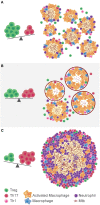Regulatory T Cells in Mycobacterium tuberculosis Infection
- PMID: 31572365
- PMCID: PMC6749097
- DOI: 10.3389/fimmu.2019.02139
Regulatory T Cells in Mycobacterium tuberculosis Infection
Abstract
Anti-inflammatory regulatory T cells have lately attracted attention as part of the immune response to Mycobacterium tuberculosis infection, where they counterbalance the protective but pro-inflammatory immune response mediated by Th17 cells and especially by the better-known Th1 cells. In chronic infectious diseases there is a delicate balance between pro- and anti-inflammatory responses. While Th1 and Th17 are needed in order to control infection by Mycobacterium tuberculosis, the inflammatory onset can ultimately become detrimental for the host. In this review, we assess current information on the controversy over whether counterbalancing regulatory T cells are promoting pathogen growth or protecting the host.
Keywords: Th17 cells; Treg cells; inflammation; tolerance; tuberculosis.
Copyright © 2019 Cardona and Cardona.
Figures

References
-
- World Health Organization . Global Tuberculosis Report 2018. Geneva. (2018). - PubMed
-
- Cardona P-J. Revisiting the natural history of tuberculosis. The inclusion of constant reinfection, host tolerance, and damage-response frameworks leads to a better understanding of latent infection and its evolution towards active disease. Arch Immunol Ther Exp. (2010) 58:7–14. 10.1007/s00005-009-0062-5 - DOI - PubMed
Publication types
MeSH terms
LinkOut - more resources
Full Text Sources
Medical

